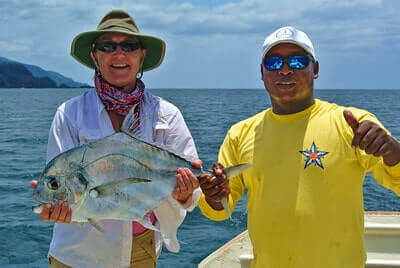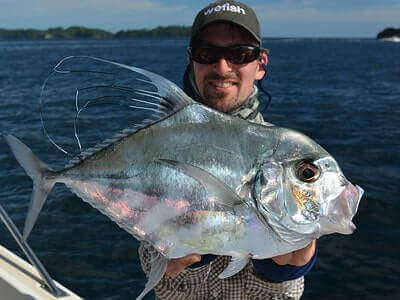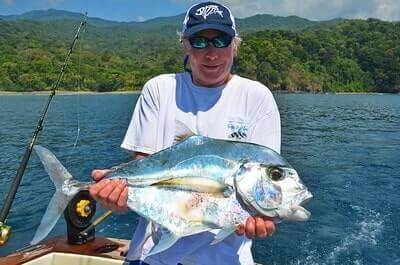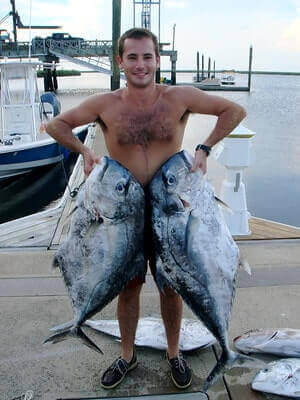Disclosure: We may earn commissions if you purchase products after clicking on a link from our site.
Are you interested in catching African Pompano? Do you want to learn how to catch African Pompano? The African Pompano is a pre-historic-looking fish species that is elusive and challenging to catch. It is aggressive, hard fighting, and a member of the Jack family of fish. It lives around structures at different depths in the water.
In this article, we discuss how to catch the African Pompano, the best fishing methods to use, the fishing tackle, baits, and lures to be successful in catching this large and tasty fish.

Table of Contents
How To Catch African Pompano
African Pompano is usually found around structures like ledges, reefs, and wrecks. It is a round, silvery fish that is attracted to flashy objects and movement. African Pompano are often found in coastal waters and in temperature ranges from 65 to 80 degrees Fahrenheit. The middle to bottom of the water column is where they are often found.
Baitcasting, bottom bouncing, drift fishing, fly fishing, jigging, trolling, and still fishing are some of the fishing methods used when fishing for African Pompano.
1. Baitcasting
Baitcasting is a popular fishing method anglers use when fishing for many species of fish. It involves casting the bait into the water and retrieving it. When the bait is cast into the water, anglers will slowly move it to mimic the movement of baitfish to get the attention of African Pompano or other predator fish.
The aim is to entice a bite. If the fish bites, the angler will set in the hook and reel in the fish. Baits and lures are used when baitcasting. It can be done from the shore or from a boat.
2. Drift Fishing
Drift fishing is a popular technique for targeting African pompano, particularly when fishing over expansive sandy flats or along coastal drop-offs and channels. Anglers allow the boat to drift naturally with the current while presenting baits or lures at various depths and locations to cover a broad area.
Common drift fishing setups include using live bait rigs, weighted jigs, or soft plastic lures dragged along the seafloor or suspended in the water column. By drifting with the current, anglers can effectively cover different habitats and increase their chances of encountering feeding pompano.
It’s essential to monitor tide and current conditions and adjust drift speed and direction accordingly for optimal results. NOAA’s guidelines on sustainable fishing practices can help ensure the responsible pursuit of African pompano.
3. Jigging
Jigging is a highly effective fishing method for targeting African pompano, particularly around reefs, wrecks, and other underwater structures where these fish often congregate. Anglers use specialized heavy jigs designed to mimic the appearance and movement of small baitfish or squid, which are the primary prey for pompano.
By dropping the jig vertically through the water column and then employing a rhythmic jigging motion, anglers create an enticing presentation that can trigger aggressive strikes from pompano. The key to successful jigging for African pompano lies in varying the depth, speed, and pattern of the jigging motion to match the fish’s feeding behavior and preferences.
It’s essential to pay close attention to sonar and fishfinder readings to locate schools of pompano and position the jig at the optimal depth. Additionally, incorporating natural scent attractants or adding bait strips to the jig can further enhance its effectiveness in enticing pompano to bite.

4. Trolling
Trolling is another productive method for catching African pompano, particularly when targeting them in open water or along the edges of reefs and drop-offs. Anglers deploy trolling rigs equipped with artificial lures or natural baits behind a moving boat, covering a large area of water to locate feeding pompano.
Popular trolling lures for pompano include diving plugs, feathers, and skirted lures that imitate the movement of small baitfish or squid. Varying the trolling speed and direction can help trigger strikes from pompano, and anglers may also incorporate planers or downriggers to achieve the desired depth.
By following the best practices outlined by NOAA, anglers can ensure responsible fishing practices and contribute to the conservation of African pompano populations.
5. Fly Fishing
Fly fishing for African pompano can be an exhilarating experience, combining the thrill of sight casting with the challenge of enticing these elusive fish to strike a fly. Anglers typically target African pompano in shallow coastal waters, where they often patrol sandy flats, drop-offs, and coral reefs in search of prey.
To effectively fly fish for pompano, anglers typically use lightweight saltwater fly rods paired with weight-forward floating lines and fluorocarbon leaders to provide stealth and accuracy in presentation. Flies designed to mimic small baitfish, crustaceans, or shrimp are popular choices for targeting pompano, with patterns such as Clouser Minnows, Gotchas, and Crazy Charlies being particularly effective.
Anglers employ a variety of casting techniques, including overhead casts, side casts, and roll casts, to present the fly accurately to cruising pompano. Patience and keen observation are crucial when fly fishing for African pompano, as anglers must carefully watch for subtle signs of feeding activity or the distinctive silver flashes of pompano as they move through the water.
6. Still Fishing
Still fishing, also known as bottom fishing, is a popular and effective method for targeting African pompano, particularly around structure-rich areas such as reefs, wrecks, and drop-offs. Anglers typically anchor their boats over productive spots where pompano are known to frequent, using live or cut bait presented near the bottom to entice strikes.
Common baits include small fish like pilchards, mullet, or squid, as well as crustaceans like shrimp or crabs, which are often rigged on circle hooks or J-hooks with a sliding sinker or fish finder rig to keep the bait near the ocean floor.
The key to successful still fishing for African pompano lies in locating productive areas with strong currents or areas of upwelling where these fish are likely to congregate in search of food. Anglers must maintain a watchful eye on their lines for subtle bites or sudden movements indicating a pompano has taken the bait. Patience is essential when still fishing, as it may take time for pompano to locate and strike the bait.
7. Bottom Bouncing
Bottom bouncing is a dynamic fishing technique used to target African pompano, particularly in areas with uneven or rugged terrain such as reefs, rocky bottoms, and underwater structures. Anglers employ specialized rigs designed to keep their bait or lure in constant contact with the ocean floor as they move the boat slowly along the bottom.
This method allows anglers to cover a wide area while presenting their offering at various depths, increasing the likelihood of enticing a strike from pompano. Common rigs for bottom bouncing include Carolina rigs or drop shot rigs, which feature a sinker attached below the main line with a leader line holding the bait or lure above.
Baits often used for bottom bouncing include live or cut baitfish, squid strips, or artificial lures designed to mimic the movements of prey species. The key to success with bottom bouncing lies in maintaining contact with the bottom while simultaneously imparting subtle movements to the bait or lure to attract the attention of nearby pompano.
Anglers must remain vigilant for the slightest indication of a strike, as pompano often hit the bait with lightning-fast speed. By mastering the art of bottom bouncing and adapting to changing conditions, anglers can increase their chances of hooking into African pompano while exploring the diverse underwater landscapes where these prized game fish reside.
8. Vertical Jigging
Vertical jigging is an effective method for targeting African pompano, especially when they are holding over deep wrecks, reefs, or other underwater structures. Anglers use heavy metal jigs that resemble baitfish or squid, dropping them vertically through the water column and then jigging them up and down to attract the attention of pompano.
The erratic movement of the jig mimics the behavior of wounded prey, enticing the fish to strike. It’s essential to vary the jigging action and depth to find the optimal presentation for the pompano’s feeding preferences.
9. Bottom Fishing
Bottom fishing is a traditional and effective method for targeting African pompano, particularly around rocky outcrops, reefs, and underwater structures where these fish are known to congregate. Anglers use heavy tackle and rigs equipped with weight sinkers to keep the bait near the seafloor, where pompano often forage for food.
Baits such as cut fish, squid, shrimp, or crabs are commonly used to entice pompano to bite. Patience is key when bottom fishing for pompano, as anglers may need to wait for the fish to find and investigate their bait.
10. Live Bait Fishing
Live bait fishing can be highly effective for catching African pompano, as these fish are known to prefer fresh, lively prey. Anglers typically use small live fish, such as pilchards, mullets, or pinfish, rigged on a hook and presented near the bottom or suspended in the water column using a float or balloon.
The natural movement of the live bait can attract the attention of pompano and entice them to strike. It’s essential to match the size and species of the live bait to the preferences of the pompano in the area.
11. Casting Lures
Casting lures is a versatile and exciting method for targeting African pompano, particularly in shallower coastal waters or around structure-rich environments such as jetties and rock formations. Anglers use a variety of artificial lures, including spoons, jigs, soft plastics, and surface poppers, to mimic the movement of prey species favored by pompano.
By casting these lures and retrieving them with erratic movements, anglers can elicit strikes from pompano patrolling the area in search of food. Adjusting the retrieve speed and depth can help anglers dial in on the most effective presentation for catching pompano.
African Pompano Fishing Tackle
Spinning tackle is often the choice of anglers when fishing for African Pompano. It is a large and powerful fish that puts up a serious fight when caught.

Best Bait For African Pompano
- Pilchard
Pilchards, also known as scaled sardines, are a popular and effective bait choice for targeting African pompano. These small, silvery baitfish are abundant in many coastal areas, making them readily available for anglers. Pilchards possess a natural oily scent and lively swimming action that entices predatory fish like African pompano.
Anglers often rig pilchards whole or in chunks on a variety of rigs, including Carolina rigs, drop shot rigs, or live bait rigs, depending on the fishing conditions and preferences. When targeting African pompano, anglers typically present pilchards near the bottom, as these fish tend to forage in deeper waters near reefs, wrecks, or underwater structures.
Pilchards can be fished using a variety of techniques, including drift fishing, bottom bouncing, or still fishing, allowing anglers to adapt to different conditions and locations where African pompano are found. The natural appearance and scent of pilchards make them a reliable choice for enticing African pompano to bite, providing anglers with an excellent opportunity to hook into these prized game fish.
2. Squid
Squid is a versatile and widely used bait for targeting African pompano. These cephalopods are abundant in various marine environments and are known to attract a wide range of predatory fish, including African pompano. Squid offers a natural scent and texture that appeals to these fish, making it an effective choice for anglers.
Squid can be rigged in various ways, such as whole or in strips, depending on the size of the bait and the angler’s preference. When targeting African pompano, anglers often present squid near the bottom, where these fish are commonly found around reefs, wrecks, or other underwater structures. Squid can be fished using techniques like drift fishing, still fishing, or bottom bouncing, allowing anglers to adapt to different conditions and fishing environments.
Additionally, squid can be combined with other baits or lures to enhance their effectiveness in enticing African pompano to strike. Overall, squid remains a popular and reliable bait choice for anglers targeting African pompano due to its availability, natural appeal, and effectiveness in attracting these prized game fish.
3. Shrimp
Shrimp is a highly effective bait for targeting African pompano, prized for its natural scent and enticing appearance. These crustaceans are abundant in coastal waters and are readily consumed by a variety of predatory fish species, including African pompano.
When used as bait, shrimp can be presented in different ways, such as whole, peeled, or as cut bait, depending on the angler’s preference and the specific fishing conditions. Anglers often rig shrimp on hooks using various techniques like Carolina rigs, dropper rigs, or jig heads, allowing for flexibility in presentation based on the target depth and structure.
Shrimp can be fished near the bottom, where African pompano are commonly found around reefs, wrecks, or other underwater structures. Additionally, live shrimp can provide added attraction and movement, enticing African pompano to strike. Overall, shrimp remains a popular and reliable bait choice for anglers targeting African pompano due to its availability, natural appeal, and effectiveness in attracting these prized game fish.
4. Sand Fleas
Sand fleas, also known as mole crabs, are a favored bait among anglers targeting African pompano due to their availability and attractiveness to a variety of saltwater species. These small crustaceans inhabit sandy beaches and shallow coastal areas, making them easily accessible for anglers seeking bait.
Sand fleas can be collected using specialized tools like sand flea rakes or by hand, particularly during low tide when they are closer to the shoreline. To use sand fleas as bait for African pompano, anglers typically thread them onto hooks, either whole or in pieces, depending on the size of the flea and the angler’s preference.
The presentation can vary, with some anglers opting to fish sand fleas near the bottom using Carolina rigs or dropper rigs, while others may prefer to fish them under a float to target pompano feeding in the surf zone. Sand fleas emit natural scents and movements that mimic prey, making them highly effective at attracting African pompano and enticing them to strike.
Anglers often find success using sand fleas in conjunction with other baits or lures to increase their chances of enticing these prized game fish. Overall, sand fleas are a popular and versatile bait option for anglers pursuing African pompano in coastal waters.
5. Cigar Minnows
Cigar minnows are a popular bait choice among anglers targeting African pompano due to their availability, durability, and effectiveness in attracting a variety of saltwater species. These small fish are known for their elongated body shape and silver coloration, making them resemble small baitfish commonly found in offshore environments.
Anglers typically catch cigar minnows using cast nets or sabiki rigs near offshore structures such as reefs, wrecks, or ledges where they congregate in large schools. Once caught, cigar minnows can be rigged onto hooks either whole or in chunks, depending on the size of the bait and the angler’s preference.
The presentation can vary, with some anglers opting to fish cigar minnows on the bottom using Carolina rigs or dropper rigs, while others may choose to fish them under a float to target African pompano feeding closer to the surface. Cigar minnows release natural oils and scents that mimic prey, making them highly effective at enticing African pompano and other predatory fish to strike
Best Lures For African Pompano
- Jigs
Jigs are versatile and effective lures for targeting African pompano in both inshore and offshore environments. These lures consist of a weighted head with a hook attached and are typically adorned with a skirt or soft plastic body that mimics the appearance of baitfish or other prey species. Anglers can vary the size, color, and style of the jig depending on the prevailing conditions and the behavior of the fish.
When targeting African pompano, anglers often opt for jigs with a natural baitfish pattern, such as silver, blue, or green hues, to closely resemble the fish’s typical forage. Jigs can be fished at various depths, from near the surface to the bottom, depending on the location of the fish and the angler’s preferred fishing technique. In deeper offshore waters, anglers may vertically jig over reefs, wrecks, or other underwater structures where African pompano are known to congregate.
In shallower inshore environments, anglers can cast jigs along sandy flats, around rocky outcrops, or near jetties and piers where African pompano may be feeding. Jigs offer anglers the flexibility to experiment with different retrieves, including jigging, twitching, and slow bouncing, to entice African pompano to strike. Overall, jigs are a reliable and productive lure option for anglers seeking to catch African pompano in a variety of saltwater environments.
2. Feathers
Feathers are a traditional and effective lure choice for targeting African pompano, particularly in offshore and deepwater environments. These lures typically consist of a series of colorful feathers or synthetic materials tied onto a hook, often in a streamlined, fish-like profile.
Feather lures are designed to mimic the movement and appearance of small baitfish or other prey species that African pompano feed on. Anglers commonly deploy feather lures by trolling them behind a boat at various speeds, allowing them to flutter and dance enticingly in the water column. The vibrant colors and lifelike movement of the feathers can attract the attention of African pompano, encouraging them to strike.
Feather lures are versatile and can be rigged with or without additional attractants such as bait or scent depending on angler preference and local fishing conditions. They are particularly effective when targeting African pompano in offshore areas near reefs, wrecks, and other underwater structures where these fish are known to congregate. Anglers can experiment with different colors, sizes, and configurations of feather lures to optimize their presentation and increase their chances of success when targeting African pompano.

How To Catch African Pompano In The Gulf of Mexico
When fishing for Africam Pompano in the Gulf of Mexico, look for structures like wrecks, reefs, and ledges. Focus on the water columns above the structures. Small jigs are the best option when fishing for African Pompano in the Gulf of Mexico.
Drift fishing is the popular fishing method used when fishing for African Pompano, but baitcasting, jigging, trolling, still fishing, and night fishing are also used to catch this elusive and delicious fish. Baits such as pilchards, sardines, herring, shrimp, and squid can also be used to catch African Pompano.
African Pompano Fishing Tips
- African Pompano is a schooling fish. Therefore, when you locate a school, you may end up catching many.
2. African Pompano is often found around structures like ledges, reefs, and wrecks.
3. They are often found around shallow wrecks and chumming is used with live bait to attract and catch them.
4. As a schooling fish, always cast your bait behind the one you caught as there will often be others following the one you caught.
5. African Pompano can avoid a leader that is more than 50 pounds. Fluorocarbon leaders are the best to use when fishing for African Pompano.
6. There is a chance that it carries ciguatera poisoning.

7. African Pompano has a silver body with a metallic look and appears to be armor-plated.
8. Live pilchards, shrimp, squid, sand fleas, and cigar minnows are baits that can be used when fishing for African Pompano.
9. Trolling, still fishing, bottom bouncing, baitcasting, drift fishing, fly fishing, and jigging are some of the fishing methods used when fishing for African Pompano.
10. The peak season for African Pompano is from November to February.
11. Chumming can be effective when fishing for African Pompano.

The Bottom Line
African Pompano is a member of the Jack family of fish. They can be found around structures like reefs, ledges, and wrecks. It is a schooling fish that is found from New Jersey to Florida and the Gulf of Mexico. November to February is the best time to fish for African Pompano.
In this article, we discussed how to catch African Pompano, the best baits, and lures, as well as shared information on the best fishing methods used by anglers. You can also read how to catch pompano and how to catch alligator gar.